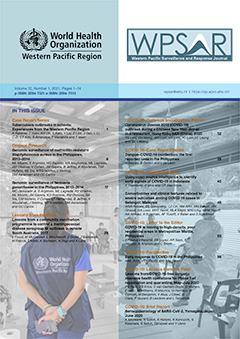COVID-19 is moving to high-density, poor residential areas in Metropolitan Manila, Philippines
DOI:
https://doi.org/10.5365/wpsar.2020.11.2.003Abstract
We describe three waves of COVID-19 infections in Manila. First, imported cases among Chinese nationals; second, infections amongst Filipinos residing in less densely populated areas; and third, infections amongst Filipinos residing in high-density areas. We highlight this using admissions data from the National Infectious Diseases hospital in Manila.
References
Edrada M, Lopez E, Villarama J, Villarama E, Dagoc B, Smith C, et al. First COVID-19 infections in the Philippines: a case report. Trop Med Health. 2020;48(21):1–7.
Republic of the Philippines Department of Health. COVID-19 TRACKER [Internet]. [cited 2020 Apr 15]. Available from: https://www.doh.gov.ph/covid19tracker
Philippine Society for Microbiology and Infectious Diseases. Interim guidelines on the clinical management of adult patients with suspected or confirmed COVID-19 infection. Version 2.1 as of 31 March 2020;
Republic of the Philippines Department of Health. DOH reports efforts to conduct more tests, prepare more quarantine facilities, and backs “science-based approach” to determine interventions. 2020.
IATF. Inter-agency task force on the emerging infectious diseases resolution number 139 12 [Internet]. 2020. Available from: https://www.officialgazette.gov.ph/downloads/2020/03mar/20200328-JOINT-MEMORANDUM-CIRCULAR-NO-1-S-2020.pdf%0D%0A

